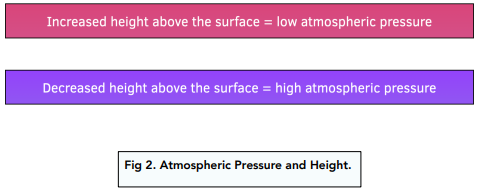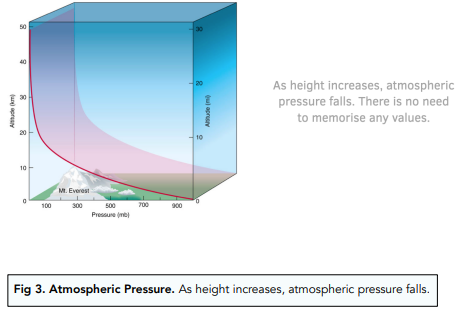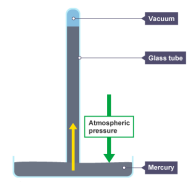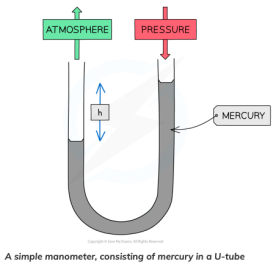Atmospheric Pressure (GCSE Physics)
Atmospheric Pressure
Atmospheric Pressure
- Atmospheric pressure is caused by particle collisions. When particles in the air collide with surfaces, they create atmospheric pressure. We previously mentioned that when a force is exerted onto an area, it results in pressure. In this case, the particles in the air are exerting forces onto surfaces, causing atmospheric pressure.
- Atmospheric pressure decreases with height. As the height above the surface of the Earth increases, the atmospheric pressure decreases. Similarly, as the height above the Earth’s surface decreases, the atmospheric pressure increases.

There are two key reasons that explain why atmospheric pressure decreases with height:
- Changes in Density – as the height above a surface increases, there are fewer air molecules per unit area. This means that the higher up we go, the lower the density of the air. In turn, this will mean fewer collisions per unit area and therefore lower atmospheric pressure.
- Changes in Weight – as the height above a surface increases, the weight of the air above the surface will decrease. This decrease in weight causes a lower atmospheric pressure.

Measuring Pressure
Barometer
We can use a barometer to measure changes in atmospheric pressure. Most barometers we use are made of a long glass tube, containing mercury. The tube opens up to a reservoir below.
If the atmospheric pressure is high, a force will be exerted downwards on the mercury in the reservoir. The mercury will be pushed up the tube.
If the atmospheric pressure is low, there is little force exerted downwards on the mercury in the reservoir. The mercury will move lower down the tube.

Manometer
We can use a manometer to measure other changes in pressure. Most manometers are made of a glass U-tube filled with mercury.
The pressure to be measured is connected to one end of the U-tube. As this pressure increases, it pushes the mercury around the U-tube. The other end of the U-tube is open to the atmosphere.
The difference in height of the two levels of mercury on either side of the tube is used to work out the change in pressure.

Atmospheric pressure is the force exerted by the weight of air molecules on objects on the Earth’s surface. It is also sometimes referred to as air pressure.
Atmospheric pressure is caused by the weight of air molecules above the Earth’s surface. The closer to the Earth’s surface, the more air molecules there are, so the greater the pressure.
Atmospheric pressure is usually measured using a barometer, which is a device that measures the weight of the air. The most common type of barometer is a mercury barometer, which uses the weight of a column of mercury to measure atmospheric pressure.
The units of atmospheric pressure are usually either millibars (mb) or kilopascals (kPa). In the United States, inches of mercury (inHg) is also commonly used.
The standard atmospheric pressure at sea level is 1013.25 millibars (mb) or 101.325 kilopascals (kPa).
Atmospheric pressure decreases as you go higher in the atmosphere. This is because there are fewer air molecules at higher altitudes, so the weight of the air above is less.
Atmospheric pressure can affect weather by causing air to move from high pressure areas to low pressure areas. This movement of air can cause winds and storms.
Changes in atmospheric pressure can affect the human body, especially during activities such as scuba diving or flying. This is because the change in pressure can cause changes in the volume of air in the lungs, which can lead to discomfort or injury if not properly managed.
A vacuum is an area with no air or other matter. It is the opposite of atmospheric pressure.
Yes, atmospheric pressure is used in a variety of practical applications, such as in the operation of vacuum cleaners, suction cups, and barometers. It can also be used to generate electricity in certain types of power plants.





Still got a question? Leave a comment
Leave a comment